FRESH, WINTER CORN SALAD
A Welcome Weed
I am happy and proud to admit that I have firmly established a weed in my garden. That weed is corn salad (Valerianella olitoria). Not that it took a lot of effort on my part; this plant is after all a weed, one that got its name for the way it invades European corn fields — “corn,” in the Queen’s English, being any grain except for corn, which is “maize.” I can still call it a weed because a definition of a “weed” is any plant that shows up where it’s not desired; much of corn salad here comes up where I don’t want it to.
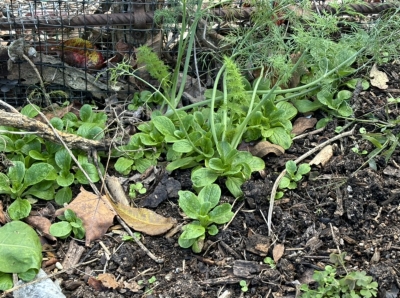
Corn salad, the weed
The second part of this weed’s name, “salad,” explains why I nonetheless want it in my garden. Corn salad, also known as màche (pronounced “mosh”, the more euphonious name, which I prefer), lamb’s lettuce, and fetticus, is a tasty salad green forming rosettes of small, dark green, spoon-shaped leaves. The leaves are not crisp like lettuce, but so tender as to almost melt in your mouth. To some people, the leaves lack any flavor; to me the flavor is delicate and flowery, something like rose petals.
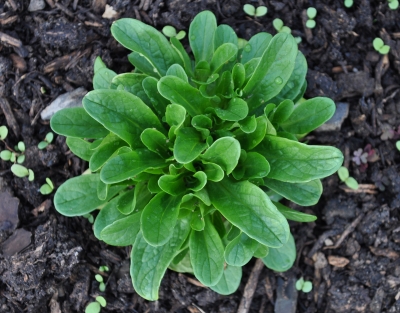
Corn salad, the garden plant
Despite its apparent delicacy, màche is a tough plant. It self-seeds readily and tolerates enough cold to grow happily through fall and then even survive winter here in Zone 5b. Like I said, it’s a weed.
As would be expected, it thrives in the very cool temperatures, especially in a minimally heated greenhouse, cold frame, or tunnel.
A Convenient Growth Cycle
Many years ago, the plant caused me trouble. Despite careful sowing of fresh seeds, germination would be slow and spotty.
After acknowledging self-seeding plants that always showed up here and there in my garden to flaunt my efforts, I decided to try growing it by capitalizing on its weedy nature. All that was needed was my becoming less fastidious about pulling up all the plants going to seed. The result? More màche seedlings.
The seedling’s coming up first in shaded areas — whether from seed sown by me or self-sown — eventually clued me in on the reason for the poor results of my deliberate sowings: the seeds only germinate at cool temperatures. So now, if I do want to deliberately plant màche somewhere from seed, I wait until late summer or early fall to plant. Or I sow in a seed flat that I keep on the cool, north side of my house until sprouts appear, then transplant the seedlings out to the garden. Or I cover sown seed with a board to keep the soil below cool and moist.
Mostly what I do these days is easiest of all, just dig up and move clumps of self-sown seedlings to wherever I want the plants to establish themselves. The seedlings transplant easily. Or I transplant small, self-sown plants to seed flats to grow large before transplanting into the ground. 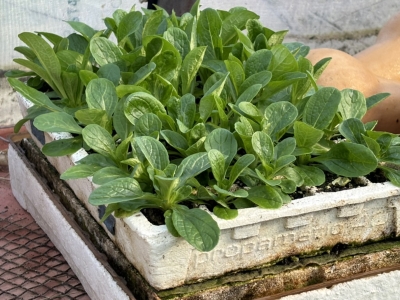 The latter method is what I do in my greenhouse, where plants grow large — for mâche, that is — when heads are subsequently spaced out in rows.
The latter method is what I do in my greenhouse, where plants grow large — for mâche, that is — when heads are subsequently spaced out in rows.
Look in any good vegetable seed catalogue and you’ll come upon a few different varieties of màche. Letting plants self-sow for harvest or transplanting doesn’t offer that choice of varieties. At best, if plants only self-pollinate, all seedlings will be that same variety.
Looking at the 100-year-old seed catalog of the still extant French Vilmorin Farming Company (the British version is available as the book The Vegetable Garden by MM. Vilmoris-Andrieux), I see four varieties listed, differing in leaf and plant size, plant shape, and hue of their leaves.  Of course, Mâche Ronde à Grosse Graine (Large Seeded Corn Salad), “a strong growing kind with greater size of plant, and also of seed” would seem highly desirable, and is still available today. I’ve grown a few different varieties, and the resulting plants never seemed sufficiently distinctive to warrant the trouble of growing them from seed.
Of course, Mâche Ronde à Grosse Graine (Large Seeded Corn Salad), “a strong growing kind with greater size of plant, and also of seed” would seem highly desirable, and is still available today. I’ve grown a few different varieties, and the resulting plants never seemed sufficiently distinctive to warrant the trouble of growing them from seed.
What does seem interesting in that old Vilmorin catalog is Italian Corn Salad, also known as Golden Corn Salad (V. eriocarpa). It differs from V. olitoria in having leaves that are slightly hairy with a golden tint. Most significantly, come spring it is less anxious to run to seed. This native of southern Europe is also less hardy than Common Corn Salad.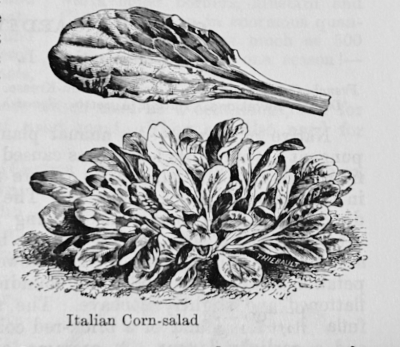
Convenient Life Cycle
Of course, self-sown seedlings do not come up in neat, gardenesque rows, but in amorphous patches near where plants previously stood. Plants also come up thickly, as well as in places where they are not wanted. Paths, for example.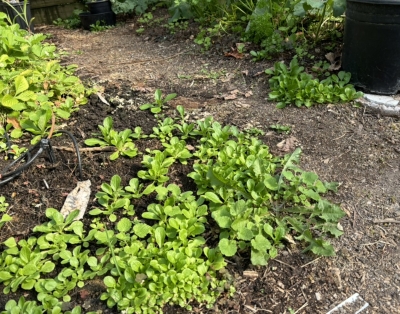
Fortunately, màche is easy to weed out where it’s not wanted. And as for coming up too thickly, plants can be thinned out to let those that those that remain grow larger, or a scissors can be used to “mow” crowded clumps of plants for harvest.
Whether within or without a greenhouse, fall and winter are the best times for growing corn salad. Just a bit of extra protection — a covering of clear plastic or the warm, south wall of a house, for example — keeps plants not only alive, but even growing during winter. 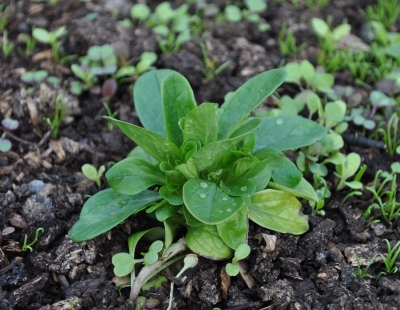
Come spring, warming temperatures and lengthening days prompt màche to go to seed. Not that those leaves taste bad even then. As temperatures warm further in spring, the season for màche passes. The tangle of seedstalks makes it easier to pull out spent plants.
The few, well-placed, gone-to-seed plants that I leave ripen seeds which drop to the ground. Màche is not a spring or summer weed. It conveniently waits until cooler weather in late summer and fall before sprouting for the fall and winter crop.
Those lush, dark green leaves seem like just what a body needs n the dead of winter, and màche does, in fact, contain goodly amounts of potassium, iron, and vitamins B6 and C. But mostly I grow it for good eating.



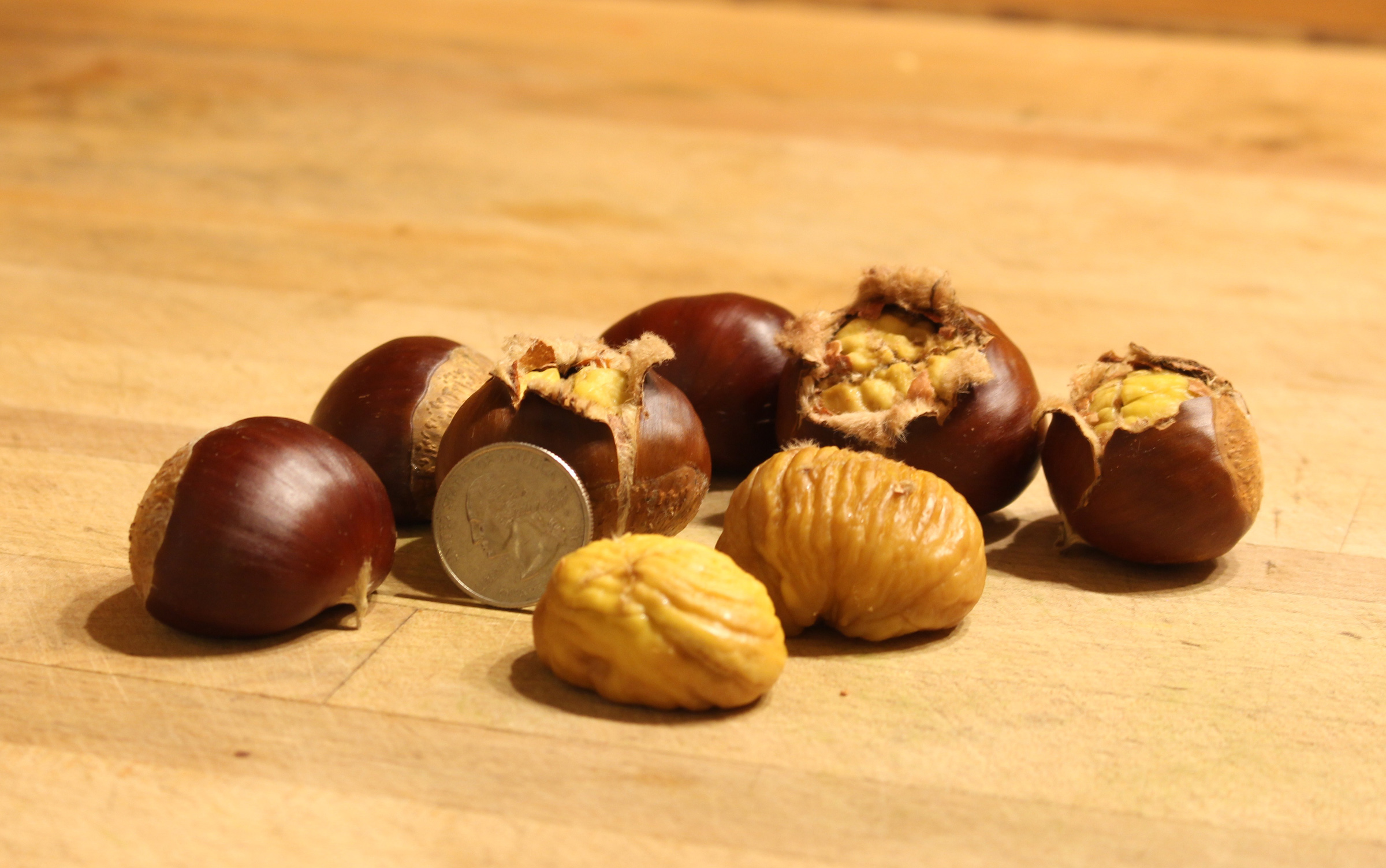
I have grown this in my winter garden as an experiment after watching a gardener from Sweden ( on YouTube) show her picking it out from under the snow to have a fresh green salad or added to a sandwich in winter. I am usually able to find seeds locally.